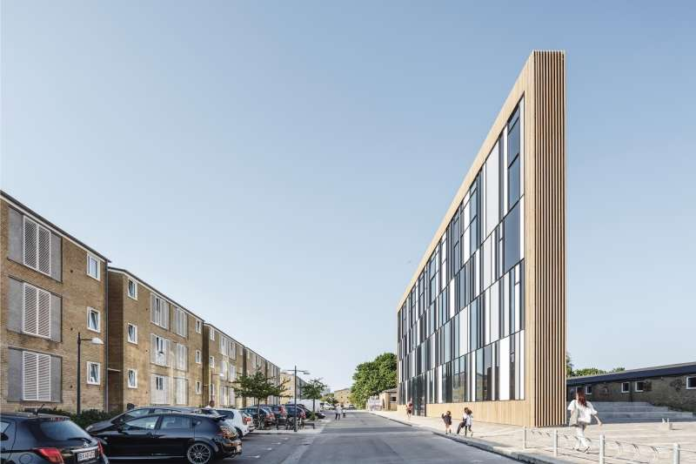Danish architecture studio COBE designed this cultural institution as a slender, seamless shell that challenges the scale and formal expression of its surroundings while still anchoring itself in the existing context.

Af Catherine Langer
The library and culture house opened its doors in October 2018 and was created as a collaboration between the City of Copenhagen, COBE and social housing corporations FSB and SAB. As the first step in the development of the socially vulnerable neighborhood of Tingbjerg, the iconic library is located next to the local school, as a gathering point between residential housing units and green areas.
Tingbjerg is a modernist housing project designed by architect, urban planner and theorist Steen Eiler Rasmussen and landscape architect Carl Theodor Sørensen. Built from 1950 to 1972 as a tightly composed residential district, it was created as an attractive alternative to the congested city center of Copenhagen. With all its houses built in yellow brick, the city district is coherent and complete with its own school, church, pedestrian shopping street, and residential housing area.

With time, the conception of Tingbjerg as a model community changed, and today the area is on the government’s list of marginalized areas, the so-called “ghetto list”. Despite its changing reputation, the district is still regarded as a cornerstone in modernist architecture and city planning.
The library is designed as a large, wedge-shaped shell that at its narrowest is just 1.5 meters wide. With its four floors, transparent windows, and iconic shape, the building stands clearly out towards the adjacent school and the surrounding low-scale residential housing. As the first new building in Tingbjerg since 1983, the library has its own landmark identity, while the rest of Tingbjerg’s buildings point back to the general modernist concept. At the same time, the building has strong bonds and grows directly out of its historic surroundings. With a cladding in yellow brick “baguettes” and a slanted roof towards the school, the library reinterprets Tingbjerg’s materials and coherent architectural language.

The inside of the building is clad in warm, wooden plywood lamellas that form a dialogue with the brick on the facade. A tall foyer space extends up vertically, connecting all four floors of the building into one unified space. The floors grow out into the foyer with niches and balconies, which gives an overview of what happens on many different floors at once. The library includes many diverse facilities in one building, including meeting rooms, a café, workshops and a flexible space that can adapt to a multitude of uses — from concerts, meetings and lectures to dance classes. The divisions between the spaces can be changed with sliding doors, while a transparent glass facade towards the street displays the activities that take place in the building through colored windows.

With its flexible spaces, the building provides the architectural framework for social and cultural activities in Tingbjerg. The library is designed as a social space that contributes to the positive development of a neighborhood that previously lacked a central gathering space. As the building is placed directly next to Tingbjerg School, a natural connection is created between the students and the library’s facilities, while the transparent facade towards the street provides safety in the area and invites the public to come inside.
Landscape architects Kragh & Berglund have created the outdoor spaces surrounding the library. Sustainability is thought into the process, as the original hand-cut cobblestones are reused in the new outdoor spaces and mixed with new concrete tiles and vegetation beds. By reusing what was already there from the beginning, the area’s new identity still seems recognizable and stays true to the original intentions of landscape architect C. Th. Sørensen.
As the first step in the future development of Tingbjerg, the library shows how investing in high-quality architecture can create a new story and identity for a challenged neighborhood. With its strong, iconic identity and transparent facade, the new library becomes a new landmark of Tingbjerg while still paying homage to the original good intentions for the neighborhood. By both respecting and breaking with tradition, the library sets the standard for the city district’s further development and points to a new future for Tingbjerg.




